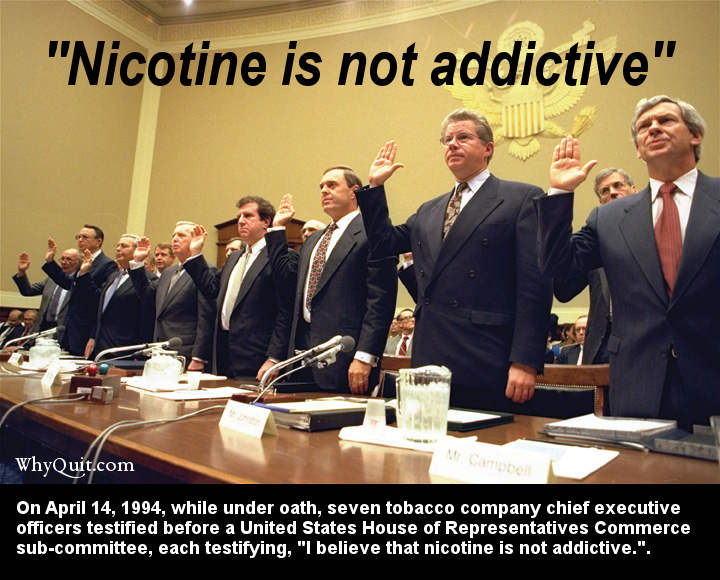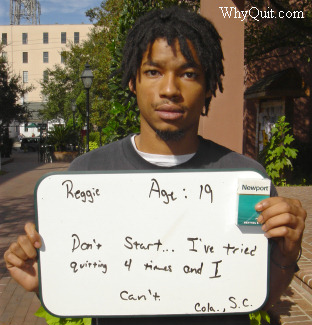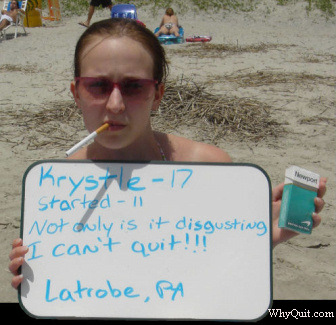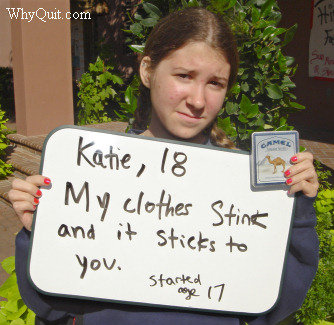
Teens, are you listening? Big Tobacco admits smoking is "highly addictive."

Click image to watch a 58 second YouTube video of CEO's testifying
If a teenager, you weren't alive 22 years ago when the heads of seven U.S. tobacco companies raised their hands and swore before a congressional committee that they believed that "nicotine is not addictive." Regrettably, until now, almost nothing has been done to correct their lies.
 While addiction warnings are printed on random packs of cigarettes in all European nations, Australia, New Zealand, Canada, Russia, and even Iran, the U.S. cigarette industry has fought hard to prevent any American teen or young adult from ever seeing a government mandated cigarette addiction warning.
While addiction warnings are printed on random packs of cigarettes in all European nations, Australia, New Zealand, Canada, Russia, and even Iran, the U.S. cigarette industry has fought hard to prevent any American teen or young adult from ever seeing a government mandated cigarette addiction warning.
But what if the warnings weren't permanent or on cigarette packs?
After a two year trial, in 2006 a federal district court issued a 1,652 page opinion finding U.S. cigarette makers liable for racketeering. In part, Judge Gladys Kessler found that cigarette companies had lied in asserting that "smoking is a free choice activity," as free choice is incompatible with addiction.
Judge Kessler found that science does not consider intoxication an element of addiction. Collectively, her order effectively asserts that addiction to smoked nicotine is every bit as real and permanent as alcoholism, or heroin or methamphetamine addiction.
Cigarette makers were ordered to pay for a one year corrective advertising campaign, to include 104 evening smoking addiction commercials to air on CBS, ABC and NBC, and two full-page addiction ads in the first section of the Sunday edition of 50 newspapers.
 The corrective statements campaign is broader than just addiction. The Court also found the defendants liable for misleading teenagers about smoking's health effects, about secondhand smoke and the truth about low tar and light cigarettes. The final consent order requires 156 additional TV commercials and 150 newspaper ads related to those topics. But to my thinking, those issues are secondary in reflecting the consequences of getting hooked.
The corrective statements campaign is broader than just addiction. The Court also found the defendants liable for misleading teenagers about smoking's health effects, about secondhand smoke and the truth about low tar and light cigarettes. The final consent order requires 156 additional TV commercials and 150 newspaper ads related to those topics. But to my thinking, those issues are secondary in reflecting the consequences of getting hooked.
On Sunday, December 10, Philip Morris USA and R.J. Reynolds will pay for full-page ads in 50 U.S. newspapers ranging from Charleston's Post & Courier, to the Los Angeles Times, to the Wall Street Journal. The ad will simply state:
A Federal Court has ordered Altria, R.J. Reynolds Tobacco, Lorillard, and Philip Morris USA to make this statement about the addictiveness of smoking and nicotine.
- Smoking is highly addictive. Nicotine is the addictive drug in tobacco.
- Cigarette companies intentionally designed cigarettes with enough nicotine to create and sustain addiction.
- It's not easy to quit.
- When you smoke, the nicotine actually changes the brain "that's why quitting is so hard."
How addictive is smoked nicotine? Highly addictive! To date, this "highly addictive" admission has never appeared on any U.S. cigarette maker's website. But why?
 Philip Morris and R.J. Reynolds are well aware that up to 90 percent of new smokers are children or teens under the age of 20. With cigarette smoking causing nearly a half a million deaths annually, the industry knows that unless replacements can be found that their drug addiction business would enter a death spiral.
Philip Morris and R.J. Reynolds are well aware that up to 90 percent of new smokers are children or teens under the age of 20. With cigarette smoking causing nearly a half a million deaths annually, the industry knows that unless replacements can be found that their drug addiction business would enter a death spiral.
Big Tobacco has gotten rich off of shotgun store and magazine marketing that strikes and preys upon the still maturing and gullible adolescent mind.
For example, take a look at cigarette ads inside magazines in your school library. Look closely at magazines such as Popular Mechanics, Popular Science, Field & Stream and ESPN Magazine. Big Tobacco knows that these magazines are being sent to schools. And for decades selective binding technology has made removal of all tobacco ads easy.
Look closely at your school's cigarette ads. Do any of them share the fact that smoking nicotine is highly addictive? If cigarette makers truly cared about youth smoking prevention would they hide smoking's most critical insight?
Yes, even in your school, to this day, Big Tobacco is attempting to make you curious, cause you to experiment, and chemically enslave you.
A November 2017 study found that, "over two thirds of people who try one cigarette become, at least temporarily, daily smokers. The finding provides strong support for the current efforts to reduce cigarette experimentation among adolescents."
Would substantially fewer teens smoke that first cigarette if aware that a May 2008 study published in Addictive Behaviors found diminished autonomy and control over continued smoking in 25% of students after smoking nicotine only once, and in 35% after smoking 3 to 4 times?
What if tobacco companies taught students the truth about smoking, that visiting Marlboro Country even once or getting infatuated with a Camel can land you behind dependency's bars for life? Don't hold your breath.
 Do you have smoking friends? Do you see them as real drug addicts? Try this. Ask them when they plan on quitting.
Do you have smoking friends? Do you see them as real drug addicts? Try this. Ask them when they plan on quitting.
According to the Centers for Disease Control, while only 5 percent of teen smokers believe they will definitely be smoking in 5 years, 75 percent will still be hooked solid 7 to 9 years later.
What if students knew what being addicted feels like, that their brain dopamine pathways would begin seeing and treating nicotine as if food. Imagine ending up feeling super hungry and starving for more nicotine 10, 15 or even 20 times a day within weeks of smoking that first cigarette.
The following additional full-page nicotine addiction related ad is scheduled to run in newspapers on Sunday, February 4, 2018:
"A Federal Court has ordered Altria, R.J. Reynolds Tobacco, Lorillard, and Philip Morris USA to make this statement about designing cigarettes to enhace the delivery of nicotine."
- Altria, R.J. Reynolds Tobacco, Lorillard, and Philip Morris USA intentionally designed cigarettes to make them more addictive.
- Cigarette companies control the impact and delivery of nicotine in many ways, including designing filters and selecting cigarette paper to maximize the ingestion of nicotine, adding ammonia to make the cigarette taste less harsh, and controlling the physical and chemical make-up of the tobacco blend.
- When you smoke, the nicotine actually changes the brain "that's why quitting is so hard."
What's astonishing is that despite my first puff ever burning so badly, tasting horrible, and making me cough, that I took a second puff. Why? Because hidden within smoke's hundreds of tissue damaging toxins was one of the planet's most captivating drugs of all.
My brain had sampled stolen dopamine. And despite feeling horrible my brain wanted more. The immediate consequences? I was about to become a real drug addict and spend the next 30 years battling to quit yet failing.
My blood stream filled with carbon monoxide that robbed blood cells of their ability to carry oxygen, I was no longer able to engage in any vigorous, prolonged physical activity.
 While hot toxins seriously damaged my ability to smell, my friends had no problem smelling the more than 4,000 chemicals that my last cigarette deposited on my hair, skin and clothing.
While hot toxins seriously damaged my ability to smell, my friends had no problem smelling the more than 4,000 chemicals that my last cigarette deposited on my hair, skin and clothing.
And try sitting in class and concentrating while battling urges and craves begging for another fix.
Smoking permanently damaged my lungs, my breathing and cost me 5 teeth. I assure you, there'd definitely be one change if only I could live life over. There wouldn't be a first puff.
My name is John and I was a 15 year-old nicotine addict. A nicotine-free addict since May 15, 1999, I remain one puff away from returning to three packs a day.
Fool me once Big Tobacco, shame on you. Fool me twice, shame on me.

